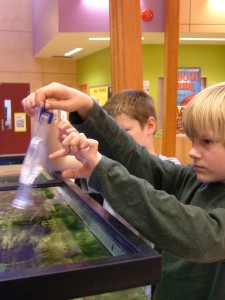Seaquaria in Schools

Originally appears in the Spring 2011 issue
It’s 1999. The phone rings. A community volunteer is greeted by the anxious voice of an elementary school student. Their beautiful Painted Anemone has a death grip on their lumbering but lovable Sea Cucumber. What should they do? They wash and rinse their hands well so that they don’t introduce any harmful chemicals into their aquarium ecosystem, reach into the tank, and gently remove the cucumber from certain death.
Ten minutes later, the cucumber is safe. With skill and compassion, the anemone was placed into a bucket of seawater and into the refrigerator for return to a more appropriate setting. The students think it is too big and aggressive to live in their “seaquarium”. They recognize that this high level predator with stinging tentacles was too much for the ecosystem in their tank.
These young stewards have taken their job as seaquarium guardians very seriously. They learned to work co-operatively, to think and act critically and to hone their leadership skills as they encountered problems that needed to be solved—largely because of the deep emotional tie they had developed with the plants and animals in their seaquarium.
With their great variety, grandeur and mystery, ocean creatures have always fascinated us. One way to provide a “living window” into the marine environments that support these creatures is to create stable ecosystems in re-circulating 70 gallon aquaria in schools. Filled with cold seawater and stocked with marine plants and animals from near shore waters, they allow everyone to experience marine environments first hand.
These seaquaria provide opportunities for young people to discover the beauty and complexity of the marine world in an interactive and emotional manner because the creatures themselves become teachers. As students observe and care for the life in their aquarium, they come to recognize, understand and respect what keeps ecosystems balanced, based on observing how the creatures themselves behave. They identify the steps needed to return the ecosystem to a more balanced state, if needed, or enhance it in different ways. Students’ own observations and actions help them to suddenly become experts on and appreciate the importance of 50 or more weird and wonderful little critters. They can make informed choices about stocking their aquarium with 50+ species that include grazers and particle feeders rather than top end predators; plants and “living rocks” for shelter and food; and bright algae and sea grasses for depth and colour. This kind of learning bears witness to the power of creatures as teachers.
This content is restricted to subscribers only.
If you are not yet a subscriber, please consider taking out a subscription here.
If you are an existing subscriber, kindly log in or contact us at info@greenteacher.com for more information.





